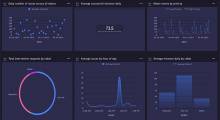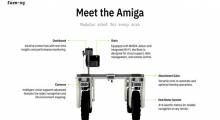The push is on to the automate the modern warehouse, disconnect the “wires” that can hamper productivity, and find new ways to keep workers safe in the current environment. As part of their overall commitment to digital transformation, many companies were already deploying automatic identification and data capture (AIDC) solutions in their warehousing and distribution operations.
COVID-19 added fuel to that fire by putting “touch-free” on the front burner for companies that suddenly had to comply with workplace social distancing rules and other requirements.
As these changes took place, the AIDC market found itself well positioned to support a physically distanced and touch-free work environment. Comprising equipment (i.e., handheld rugged mobile computers; vehicle-mounted computers; handheld and stationary bar code scanners; and thermal label printers) and mobile solutions (mobile bar code scanners and wearable computers), AIDC is now playing an even bigger role in the modern warehouse and DC environment.
“I would say that digital investments/digital transformation efforts have been—broadly speaking—elevated and accelerated in response to COVID-19,” says David Krebs, VDC Research’s executive vice president of enterprise mobility and the connected worker. With his finger on the pulse of this market, Krebs tracks both the growth of this sector plus any outside factors that are impacting it during any given year.
Right now, most of those challenges are related to the global pandemic and the impacts that it’s had on the distribution sector, which was already dealing with issues like labor shortages, an uptick in e-commerce orders, and the need for physical expansion coming into 2020. When the pandemic emerged in March, those existing challenges were amplified and then augmented with new stressors.
“The challenge for many organizations has been the balancing of their own businesses/operations with large-scale technology investments,” Krebs observes. “However, when looking at enabling the remote workforce that supports logistics businesses and the need for safe work environments and customer interactions, digital solutions that are enabled by AIDC technologies are critical.”
According to a recent VDC survey, for example, 60% of transportation/logistics organizations claim they are either overhauling or making substantial changes to their customer engagement models as a result of COVID-19. In addition, 40% of these organizations are “aggressively accelerating the pace at which they are rolling out mobility/AIDC solutions to their frontline mobile workforce,” Krebs says.
Top 20 Automatic Data Capture Suppliers 2020
| Company Name | 2020 Rank | 2019 Rank | 2019 Revenues (USD, in millions) |
2018 Revenues (USD, in millions) |
Year over Year Change |
| Zebra Technologies (includes Motorola Solutions, Psion) | 1 | 1 | 2603.3 | 2503.8 | 4.0% |
| Honeywell (includes LXE, Intermec, Datamax-O’Neil) | 2 | 2 | 798.4 | 888.9 | -10.2% |
| Datalogic | 3 | 3 | 582.4 | 625.2 | -6.8% |
| SATO | 4 | 4 | 264.5 | 229 | 15.5% |
| Cognex | 5 | 5 | 149.1 | 175.3 | -14.9% |
| Toshiba TEC | 6 | 6 | 174.3 | 171.8 | 1.5% |
| Denso Wave | 7 | 7 | 134.5 | 137.8 | -2.4% |
| Panasonic | 8 | 8 | 97.2 | 126.3 | -23.0% |
| TSC Printers | 9 | 9 | 116.7 | 113.6 | 2.7% |
| Fujian Newland | 10 | 10 | 154.5 | 112.1 | 37.8% |
| SICK AG | 11 | 11 | 140.8 | 104.2 | 35.1% |
| Casio Computer Co. Ltd | 12 | 12 | 81.0 | 88.0 | -8.0% |
| Shandong New Beiyang | 13 | 13 | 83.9 | 86.2 | -2.7% |
| Keyence | 14 | 14 | 104.1 | 80.0 | 30.1% |
| Bluebird Corp. | 15 | 15 | 68.0 | 79.1 | -14.0% |
| Unitech | 16 | 16 | 55.4 | 55.3 | 0.2% |
| Vitronic | 17 | 17 | 52.8 | 49.8 | 6.0% |
| Avery Dennison | 18 | 18 | 48.5 | 47.5 | 2.1% |
| cab Produkttechnik GmbH | 19 | 19 | 47.5 | 45.5 | 4.4% |
| Omron | 20 | 20 | 44.5 | 42.2 | 5.5% |
| TOTAL | 5801.4 | 5761.6 | 0.7% |
| Company Name | North American HQ | Bar code printers | Handheld scanners | Stationary scanners | RFID | Mobile computers |
| Schaumburg, Ill. | X | X | X | X | X | |
| Honeywell (includes LXE, Intermec, Datamax-O’Neil) | Morristown, N.J. | X | X | X | X | X |
| Datalogic | Eugene, Ore. | X | X | X | X | |
| SATO | Charlotte, N.C. | X | X | |||
| Cognex | Natick, Mass. | X | X | |||
| Toshiba TEC | Irvine, Calif. | X | X | |||
| Denso Wave | Southfield, Mich. | X | X | |||
| Panasonic | Newark, N.J. | X | ||||
| TSC Printers | Pomona, Calif. | X | ||||
| Fujian Newland | Fremont, Calif. | X | X | X | X | |
| SICK AG | Minneapolis, Minn. | X | X | |||
| Casio Computer Co. Ltd | Dover, N.J. | X | X | |||
| Shandong New Beiyang | Shandong, China | X | X | |||
| Keyence | Itasca, Ill. | X | X | X | X | |
| Bluebird Corp. | Palisades Park, N.J. | X | X | |||
| Unitech | Los Angeles, Calif. | X | X | X | ||
| Vitronic | Wiesbaden, Germany | X | ||||
| Avery Dennison | Glendale, Calif. | X | X | |||
| cab Produkttechnik GmbH | Tyngsboro, Mass. | X | ||||
| Omron | Hoffman Estates, Ill. | X | X |
Tracking market trends
The AIDC market reached $6.49 billion in 2019 and is projected to decline to $5.85 billion in 2020, according to VDC. Between 2019 and 2024, the market is expected to post a compound annual growth rate (CAGR) of 3.8%, driving overall revenues to $7.83 billion by 2024.
Divided into three categories—rugged mobile hardware, bar code scanners, and bar code label printers—the market’s biggest movers over the next four years will be rugged handheld computers (with 5.8% CAGR) and mobile printers (5.6%).
While the overall market showed minimal growth in 2019, according to Krebs, he says that there was a pretty wide disparity in terms of overall performance on a vendor-by-vendor basis. For example, Zebra (No. 1), the leading vendor by a wide margin, was able to continue to solidify its position as overall revenues grew 4%. “Companies like SATO (No. 4), Fujian Newland (No. 10) and SICK (No. 11) posted substantial double-digit gains, year-over-year,” Krebs adds.
Other companies rounding out VDC’s list of top AIDC vendors this year were Honeywell (No. 2), Datalogic (No. 3), Cognex (No. 5), Toshiba TEC (No. 6), Denso Wave (No. 7) and Panasonic (No. 8). These companies’ year-over-year revenue comparison was a mixed bag, with some posting increases as high as 37.8% over 2019 (Fujian Newland) and others reporting decreases of up to 23% (Panasonic).
These numbers include only hardware revenues for handheld rugged mobile computers, vehicle mounted computers, handheld and stationary bar code scanners, and thermal label printers. VDC doesn’t include RFID, rugged tablets, wearable computers, printer consumables, or accessories and services in its report.
Within the AIDC realm, another trend VDC continues to track is the emergence of Asia-based brands globally. With success once limited to their home markets, Krebs says the research firm is seeing companies like Newland, Urovo, Chainway and others establish stronger positions in Europe, the Middle East and Latin America. “Conversely,” he adds, “[very] few of these emerging brands have been able to significantly crack the North America market.”
AIDC software vs. hardware
Asked whether he’s seeing the lines continue to blur between AIDC software and equipment, Krebs says that while the Top 20 AIDC vendors continue to generate the lion’s share of their revenues from hardware sales, that trend is beginning to shift slightly.
“When looking at research and development (R&D) investments—which typically represent around 10% of revenues—the emphasis has clearly shifted toward software investments,” says Krebs. “We’ve seen this especially with the shift toward Android in the mobile computer/handheld category, but it also applies to printing, scanning and machine vision solutions.”
“This will be a key theme in 2020 and beyond,” Krebs continues, “and we expect it to also influence M&A decisions.”
Collecting the data
This is our 18th-annual look at the leading manufacturers of ADC hardware and solutions. Because the industry includes public and private companies, this is the 12th year that VDC Research Group compiled our data. Because they are covering this technology every day, they are closer to the market. To make our list, companies must sell in North America, though the chart includes worldwide revenues. We do not include resellers, systems integrators or other companies that do not manufacture ADC hardware. Because our readers are primarily focused on supply chain solutions, we do not include companies whose primary focus is the retail checkout counter or non-industrial settings, like hospitals, libraries or resorts. Nor do we include companies that only manufacture consumables like bar code labels and RFID tags.
Measuring the impacts
In 2020, COVID-19 impacted nearly all industries worldwide and exacted a particularly high toll on supply chain operations, many of which were severely disrupted when the pandemic hit. Some operations have since recovered while others continue to struggle under the weight of COVID, the economic downturn and other factors.
“Demand forecasting accuracy—especially around consumer products—has been a mess, straining the capabilities of typical supply chain operations,” Krebs points out. “Clearly, visibility into supply chain operations has taken on new meaning as organizations need to be much more agile to respond to quickly changing consumer habits.”
And while final-mile logistics have been a perpetual challenge for many, COVID exacerbated those woes by forcing people to stay at home to work, shop and live. “Last mile has always been a challenge, but now when you include increased demand for grocery online business and home delivery, those challenges are even more acute,” Krebs says.
In addition, the competition between logistics organizations and e-commerce giants concerning delivery services continues to intensify. “In response to some of these pressures, we’ve seen logistics organizations look to alternative technologies such as passive RFID and vision systems, plus make investments in automation and robotics,” Krebs says, “to squeeze even greater operational benefits from their already streamlined operations.”
Forever evolving
Looking ahead, Krebs expects the AIDC market to continue evolving at a steady pace. However, when it comes to the technology that enables global supply chains to operate smoother and businesses to collaborate, he says “much still needs to be done to support and enforce truly global standards.”
For example, demands for greater traceability in the food and beverage, pharmaceutical and automotive component sectors continues to grow, driving the need for companies to identify products and key unique attributes about these products.
“Digitally connecting consumers with products similarly represents a continuing challenge for retailers, brand owners and logistics partners,” Krebs concludes, noting that the demand platforms that enable secure and seamless data sharing among trading partners isn’t going to wane anytime soon.
“The technology continues to evolve, and we’re seeing a lot of innovation around camera technology, computer vision and artificial intelligence (AI),” says Krebs, “that will show up in many use cases from the factory floor to the loading dock.”
About the Author
Follow Robotics 24/7 on Linkedin
About the Author
Follow Robotics 24/7 on Linkedin
Article topics
Email Sign Up




















